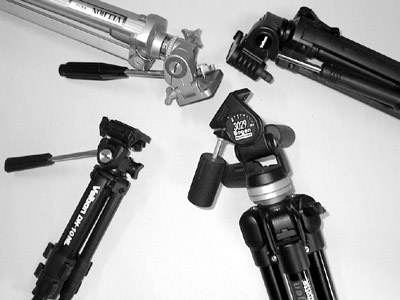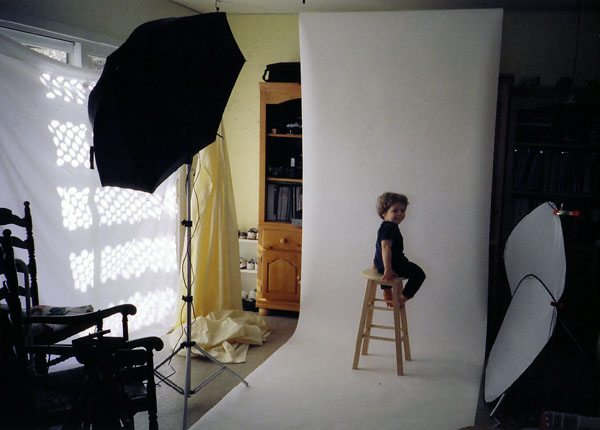Other Cameras?
Believe it or not, this isn't the full extent of my collection, just the classics and working notables. I also have some dogs and clunkers that frankly aren't really worth a page of their own, and a few that are but I just haven't gotten around to yet.
Our geneaology of family cameras, previously outlined here, have been forced by the marketplace into classic status, so now they have their own pages, mostly by virtue of being film cameras :) Our latest addition (late 2005) is a Kodak EasyShare CX7330, discontinued now but which I think is a great combination of price/performance. It's 3.1MP with a 3x optical zoom, short shutter delay, fast flash recycle, uses rechargable AA batteries, and I can take short movies on the 512MB card I got with it from TigerDirect. I bought it for my wife when she became class mom of Bailey's K1 class, so she could email the other parents pictures of class activities, and it rather quickly displaced the Nikon N6006 as the snapshot camera, leaving it and the brilliant Classic 120 to gather dust :(
When my eldest son Casey was a little guy (sniff) I gave him my little Vivitar PS:35 AF compact that I got for a pittance at Goodwill in Petaluma. It was presumably to be my backup camera to throw in my shoulder bag and always have with me, though I never really did, and so gave it up (I do now carry either the Lomo, Olympus XA2, or the Camera of the Day). The PS:35 AF is actually a really good little shooter and I've taken some nice pictures with it. You could do much worse (and spend much more). True autofocus, not 'focus-free', and a pretty sharp lens. Casey started taking pictures with it when he was two years old and he's got some pretty good shots with it as well. It got dropped, however, and now he uses a Canon Sure Shot Supreme that I got for $1, one of my best bargains! He'll get his own digital before the next vacation I think, he uses far more film than I do. He does also enjoy shooting some of my classics as well, like the C35, which is just the right size for him, or whatever else I happen to be playing with that day. So now that I think about it, that was the real beginning of the collecting, me scouting around thrift stores and antique stores for cheap old cameras in useable shape. That and visiting the photo swap in the City. (Now it's ebay and yard sales. And the occasional thrift store.)
For the record, the first camera I remember owning was a Kodak Instamatic with the little blue logo. It used Magicube flash cubes. I wonder if it's still around somewhere? And the pictures I took with it?
Tripod Madness
I have to say that though I've never particularly liked Velbon tripods, at one point I actually owned three of them. That in addition to my tripod suprema, the rock-solid Bogen 3211 with a 3029 3-way (no quick-release) pan head. I compare all tripods with my Bogen (which I bought thinking I would eventually move to a view camera - it can hold 11 pounds I think) and none have held a candle to it. However, the Bogen is far too heavy to carry around outside comfortably so I figured I'd have to settle for something else. My first Velbon (model DH-10ML, extends from 11 1/2" - 24 1/2") is a wonderful little compact tripod that went to Europe with us a few years ago. At the time it was the most stable small tripod I could find for the money and it served me well on that trip. (There's a little SLIK one about the same size, I think.) I have been looking since for a full-height semi-lightweight travel tripod and settled on a Velbon Victory 451. The 451 opens up quickly, cranks tall, operates smoothly, packs up small and is relatively light, and has a quick-release plate. However, it's not as solid as I would like, and the quick-release plate likes to shift around (I think all but the cork-topped ones do). For a while I had an older all-metal Velbon VE-3, which was almost identical to the 451 in height, both extended and folded, and seemed heavier but I think that was just because it was steel not aluminium. It was definitely more solid (vibration absorbing) but the leg base wasn't quite as wide and stable as I'd like. And the metal clips were harder to close than the quick-release clips on the 451. I've since sold them both, neither compares to the Bogen for stability. Sigh. As a compromise I got a Bogen monopod which I have yet to use for anything except a weapon...
I also have a classic Agfa tripod for those old gems that don't fit on a tripod with a modern baseplate.

Almost forgot to add that in reality I rarely use any of these supports as much as I should. I almost hate to admit it but I find tripods to be too much trouble for the type of shooting I usually do - hand-held, available light. (Though when I do I find it strangely liberating not to have to hold the camera!) To be sure, I do use a tripod for formal portrait sessions, self-portraits, and tricky low-light nature photography.
But Wait... There's More!
If anyone is still reading at this point, I thought I'd throw out a little more miscellaneous odds and ends, some of which you could guess by studying the camera pages in depth.
film - for black and white I usually shoot my favorites Plus-X, Tri-X (the faster but granier version), and either XP2 or Kodak Black and White (which used to suck but now is pretty good). Sometimes the nicely priced and smoothly toned FOMA pan. I've experimented with a lot of different films and have always come back to those. I do enjoy shooting Kodak High Speed Infrared from time to time, and have also had good luck with their superfast Recording Film 2475 (ISO 3200, now discontinued in favor of TMAX 3200). When we were in Europe in 1997 I discovered the joy of Ilford XP2, which is color process black and white film. I didn't know if I would develop over there or what I was going to do with it all so I was hedging my bets (I shot 23 rolls of various films with two cameras over ten days, and did end up developing it back home). I like the way it looks sepia toned when printed on color paper, a quick & dirty way of getting an old-fashioned look in your prints. Also in Europe I shot Ilford SFX with very good results - it's got heightened red sensitivity, not infrared exactly but just enough to add drama if you shoot with a red filter. High contrast film, not so good for high contrast lighting. I was in the process of migrating to XP2 for most black and white, partly for economy -- I can get it developed at my local Costco for pretty cheap -- but now that I have a darkroom and can do my own developing and printing it's a toss-up. I still love shooting it though, it's got great latitude and is virtually grainless.
For color I shoot primarily Kodak Gold 200 and Ektachrome, and also Fuji Superia XTRA 400 or Konica Centuria 200 when I want a slightly faster color film. For formal portraits I shoot Kodak Royal Gold 200 (sadly they recently discontinued all but 200 and 400). I can't stand Kodak MAX, it's grainy and blobby. I hate it.
developing & printing - See my darkroom notes page for traditional darkroom information. I do have a 'digitial darkrooom' in the form of an Epson Perfection 3170 that can scan 35mm and medium format negs into Photoshop on my Powerbook, but I'll be honest, I find negative scanning far more tedious than actual darkroom work. I prefer to scan the prints if I like them, since to me scanning negs is like watching paint dry and then touching it up afterwards.
gear - my main kit bag is a basic black canvas Little Bit Smaller Domke bag when I need to bring a fair amount of stuff (like for location portraits), but usually I just use a smaller Tamrac 5400 (identical to the 600R Expo Jr. in everything but color and price). Occasionally the sweet but discontinued Eddie Bauer travel bag, which I bought for our Europe trip, it holds an SLR, a couple lenses, extra film, and notebook. Otherwise I can usually be seen trekking around SLR in hand, with an extra lens in a Zing bag hanging off a belt strap. My frequent shooters without everready cases are typically outfitted with Domke shoulder straps; they're lightweight, stylish, and inexpensive, with some rubber sewn into one side of the cloth part to keep it slipping off your shoulder. They also have little leather pads by the rings to keep the rings from scratching your camera. Very nice.
studio - I have hooks in the ceiling in our rumpus room with a PVC pipe on a wire between them that can suspend a 9' seamless. Here is where I do my formal portrait photography and studio work with two White Lightning 10,000 monolights (built-in slaves, what!) and a couple of satin umbrellas with removable black covers. Fully sanctioned by SWMBO to do the kids' annual and holiday portraits!

Speaking of studio work, somebody asked me how I set up the camera 'product shots': the old way was to set the cameras on the washing machine and set up a piece of white foamcore as a backdrop, then take a picture with the macro setting on my digital camera. They're lit overhead with the fluorescent lights of the garage. A few are done on a light table with an overhead lamp and a foam background, and the rest are lit with an Ott-Lite on the kitchen counter with a piece of fingerpainting paper as a seamless. Now you know!
Comments? Questions? Kudos? Flames? Go ahead and email me. I hope you find some of this useful.
